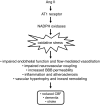Effects of angiotensin II on the cerebral circulation: role of oxidative stress
- PMID: 23316164
- PMCID: PMC3539653
- DOI: 10.3389/fphys.2012.00484
Effects of angiotensin II on the cerebral circulation: role of oxidative stress
Abstract
Oxidative stress has emerged as a key component of many diseases that affect the vasculature. Oxidative stress is characterized as a cellular environment where the generation of oxidant molecules overwhelms endogenous anti-oxidant defense mechanisms. NADPH oxidases are a family of enzymes whose primary purpose is generation of reactive oxygen species (oxidant molecules) and therefore are likely to be key contributors to oxidative stress. Hypertension is associated with oxidative stress in the vasculature and is a major risk factor for stroke and cognitive abnormalities. Angiotensin II (Ang II) is the main effector peptide of the renin-angiotensin system (RAS) and plays a critical role in promoting oxidative stress in the vasculature. In the cerebral circulation, Ang II has been implicated in reactive oxygen species generation, alterations to vasomotor function, impaired neurovascular coupling, inflammation, and vascular remodeling. Furthermore, studies in humans have shown that cerebral blood flow is altered during hypertension and therapeutically targeting the RAS improves cerebral blood flow. Importantly, many of the aforementioned effects have been shown to be dependent on NADPH oxidases. Thus, Ang II, NADPH oxidases and oxidative stress are likely to play key roles in the pathogenesis of hypertension and associated cerebrovascular disease. This review will focus on our current understanding of the contribution of Ang II and NADPH oxidases to oxidative stress in the cerebral circulation.
Keywords: NADPH oxidase; cerebral arteries; cerebral blood flow; endothelium; neurovascular coupling; nitric oxide.
Figures


Similar articles
-
Role of Nox isoforms in angiotensin II-induced oxidative stress and endothelial dysfunction in brain.J Appl Physiol (1985). 2012 Jul;113(2):184-91. doi: 10.1152/japplphysiol.00455.2012. Epub 2012 May 24. J Appl Physiol (1985). 2012. PMID: 22628375 Free PMC article.
-
Dietary nitrate improves age-related hypertension and metabolic abnormalities in rats via modulation of angiotensin II receptor signaling and inhibition of superoxide generation.Free Radic Biol Med. 2016 Oct;99:87-98. doi: 10.1016/j.freeradbiomed.2016.07.025. Epub 2016 Jul 26. Free Radic Biol Med. 2016. PMID: 27474450
-
Neurovascular Coupling in Hypertension Is Impaired by IL-17A through Oxidative Stress.Int J Mol Sci. 2023 Feb 16;24(4):3959. doi: 10.3390/ijms24043959. Int J Mol Sci. 2023. PMID: 36835372 Free PMC article.
-
Interaction between nitric oxide and angiotensin II in the endothelium: role in atherosclerosis and hypertension.J Hypertens Suppl. 2006 Mar;24(1):S45-50. doi: 10.1097/01.hjh.0000220406.46246.f2. J Hypertens Suppl. 2006. PMID: 16601573 Review.
-
Role of renin-angiotensin system in liver diseases: an outline on the potential therapeutic points of intervention.Expert Rev Gastroenterol Hepatol. 2016 Nov;10(11):1279-1288. doi: 10.1080/17474124.2016.1207523. Epub 2016 Jul 14. Expert Rev Gastroenterol Hepatol. 2016. PMID: 27352778 Review.
Cited by
-
Neurovascular coupling and cerebral autoregulation in atrial fibrillation.J Cereb Blood Flow Metab. 2020 Aug;40(8):1647-1657. doi: 10.1177/0271678X19870770. Epub 2019 Aug 19. J Cereb Blood Flow Metab. 2020. PMID: 31426699 Free PMC article.
-
Is the Brain an Early or Late Component of Essential Hypertension?Am J Hypertens. 2020 May 21;33(6):482-490. doi: 10.1093/ajh/hpaa038. Am J Hypertens. 2020. PMID: 32170317 Free PMC article. Review.
-
S-nitrosoglutathione inhibits cerebrovascular angiotensin II-dependent and -independent AT1 receptor responses: A possible role of S-nitrosation.Br J Pharmacol. 2019 Jun;176(12):2049-2062. doi: 10.1111/bph.14644. Epub 2019 May 7. Br J Pharmacol. 2019. PMID: 30822355 Free PMC article.
-
Racial disparities in cardiovascular disease risk: mechanisms of vascular dysfunction.Am J Physiol Heart Circ Physiol. 2019 Oct 1;317(4):H777-H789. doi: 10.1152/ajpheart.00126.2019. Epub 2019 Aug 9. Am J Physiol Heart Circ Physiol. 2019. PMID: 31397168 Free PMC article. Review.
-
Neurovascular signaling in the brain and the pathological consequences of hypertension.Am J Physiol Heart Circ Physiol. 2014 Jan 1;306(1):H1-14. doi: 10.1152/ajpheart.00364.2013. Epub 2013 Oct 25. Am J Physiol Heart Circ Physiol. 2014. PMID: 24163077 Free PMC article. Review.
References
Grants and funding
LinkOut - more resources
Full Text Sources
Other Literature Sources
Miscellaneous

